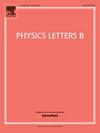高阶流系数——大型强子对撞机重离子碰撞中形成的QCD介质的信使
IF 4.5
2区 物理与天体物理
Q1 ASTRONOMY & ASTROPHYSICS
引用次数: 0
摘要
各向异性流动和波动是重离子碰撞初始态效应的敏感观测值,具有介质性质和末态相互作用的特征。利用事件形状的可观测值,可以约束各向异性流动系数的概率分布,从而减少在测量的高阶谐波中的线性和非线性贡献。本文采用横向球度作为事件形状观测值来研究流动系数和椭圆流波动。发现横向球度与椭圆流及其波动有很强的相关性。我们利用横向球形的这一特征来消除高次谐波对椭圆流的贡献。采用多相输运模型对sNN=5.02 TeV的Pb-Pb碰撞进行了研究。多粒子q累积量法估计了各向异性流动系数,降低了非流动贡献。我们观察到当椭圆流值较小时,系统对流动系数的响应更强。本文章由计算机程序翻译,如有差异,请以英文原文为准。
Higher order flow coefficients – a messenger of QCD medium formed in heavy-ion collisions at the Large Hadron Collider
Anisotropic flow and fluctuations are sensitive observables of the initial state effects in heavy ion collisions and are characterized by the medium properties and final state interactions. Using event-shape observables, one can constrain the probability distributions of anisotropic flow coefficients, thus reducing the linear and nonlinear contributions in the measured higher-order harmonics. In this paper, we use transverse spherocity as an event shape observable to study the flow coefficients and elliptic flow fluctuations. Transverse spherocity is found to have a strong correlation with elliptic flow and its fluctuations. We exploit this feature of transverse spherocity to remove the contribution to elliptic flow from higher-order harmonics. The study is performed in Pb–Pb collisions at TeV using a multi-phase transport model. The multi-particle Q-cumulant method estimates the anisotropic flow coefficients, which reduces the non-flow contributions. We observe a stronger system response to the flow coefficients for the events with smaller values of elliptic flow.
求助全文
通过发布文献求助,成功后即可免费获取论文全文。
去求助
来源期刊

Physics Letters B
物理-物理:综合
CiteScore
9.10
自引率
6.80%
发文量
647
审稿时长
3 months
期刊介绍:
Physics Letters B ensures the rapid publication of important new results in particle physics, nuclear physics and cosmology. Specialized editors are responsible for contributions in experimental nuclear physics, theoretical nuclear physics, experimental high-energy physics, theoretical high-energy physics, and astrophysics.
 求助内容:
求助内容: 应助结果提醒方式:
应助结果提醒方式:


